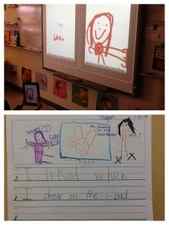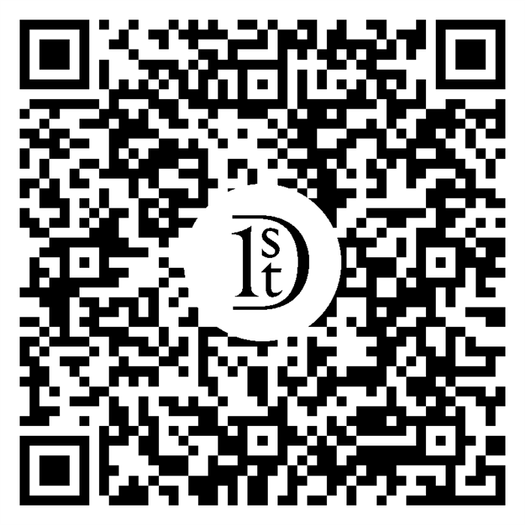Now, I apply a mixed white color to the left side of the roof in the winter landscape painting. The white color represents snow covering part of the roof area. As you can see this white mixture is a little bit lighter than the previous white mixture I created.
Winter landscape paintings created with acrylic paint
Adhesives & Tapes
Artists’ Accessories
Brushes
- Cleaners & Accessories
- Great Value Brushes
- Oil & Acrylic Brushes
- Sable Brushes
- Specialist Brushes
- Suitable For All Media
- Varnish, Priming & Gilding
- Watercolour Brushes
Canvas
- Canvas Boards & Pads
- Canvas Rolls
- Canvas Stretchers
- Colouring-In Canvas
- Stretched Cotton Canvas
- Stretched Linen Canvas
Craft Products
- Block Printing
- Children’s Products
- Craft Brushes
- Craft Paints
- Craft Paper & Card
- Decoupage
- Fabric Paints
- Face Painting
- Glitter
- Miscellaneous Crafts
- Modelling & Moulding
Easels
- Portable Easels
- Sketching Easels
- Studio Easels
- Table Easels
Mediums & Varnishes
- Acrylic Mediums
- Acrylic Varnishes
- Oil Varnishes & Mediums
- Pouring Mediums
- Watercolour Mediums
Pads, Paper & More
- Acrylic & Oil Pads
- Cartridge Paper & Pads
- Coloured Paper & Card
- Detail Paper & Pads
- Diaries
- Foamboard
- Gummed Pads
- Layout Pads
- Marker Pads
- Miscellaneous Pads & Paper
- Moleskine
- Mountboard
- Notebooks
- Paper Rolls
- Pastel Paper & Pads
- Sketchbooks
- Spiral Paper Pads
- Tracing Paper & Pads
- Watercolour Paper & Pads
Paints
- Acrylic Paints
- Gouache Paints
- Oil Paints
- Paint Sets
- Spray Paints
- Watercolour Paints
Pastels & Charcoal
Pencils
- Chinamarkers
- Coloured Pencils
- Graphite Pencils
- Pastel Pencils
- Watercolour Pencils
Pens, Markers and Inks
Portfolio
- Archival Storage
- Books With Removable Sleeves
- Portfolios With Rings
- Portfolios Without Rings
Shop Xmas
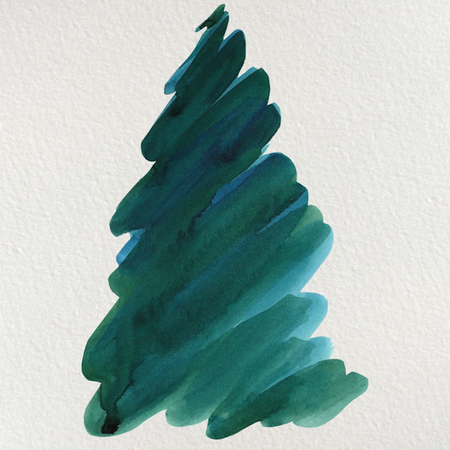
Menu
Menu
Adhesives & Tapes
Artists’ Accessories
Brushes
- Cleaners & Accessories
- Great Value Brushes
- Oil & Acrylic Brushes
- Sable Brushes
- Specialist Brushes
- Suitable For All Media
- Varnish, Priming & Gilding
- Watercolour Brushes
Canvas
- Canvas Boards & Pads
- Canvas Rolls
- Canvas Stretchers
- Colouring-In Canvas
- Stretched Cotton Canvas
- Stretched Linen Canvas
Craft Products
- Block Printing
- Children’s Products
- Craft Brushes
- Craft Paints
- Craft Paper & Card
- Decoupage
- Fabric Paints
- Face Painting
- Glitter
- Miscellaneous Crafts
- Modelling & Moulding
Easels
- Portable Easels
- Sketching Easels
- Studio Easels
- Table Easels
Mediums & Varnishes
- Acrylic Mediums
- Acrylic Varnishes
- Oil Varnishes & Mediums
- Pouring Mediums
- Watercolour Mediums
Pads, Paper & More
- Acrylic & Oil Pads
- Cartridge Paper & Pads
- Coloured Paper & Card
- Detail Paper & Pads
- Diaries
- Foamboard
- Gummed Pads
- Layout Pads
- Marker Pads
- Miscellaneous Pads & Paper
- Moleskine
- Mountboard
- Notebooks
- Paper Rolls
- Pastel Paper & Pads
- Sketchbooks
- Spiral Paper Pads
- Tracing Paper & Pads
- Watercolour Paper & Pads
Paints
- Acrylic Paints
- Gouache Paints
- Oil Paints
- Paint Sets
- Spray Paints
- Watercolour Paints
Pastels & Charcoal
Pencils
- Chinamarkers
- Coloured Pencils
- Graphite Pencils
- Pastel Pencils
- Watercolour Pencils
Pens, Markers and Inks
Portfolio
- Archival Storage
- Books With Removable Sleeves
- Portfolios With Rings
- Portfolios Without Rings
Shop Xmas

Adhesives & Tapes
Artists’ Accessories
Brushes
- Cleaners & Accessories
- Great Value Brushes
- Oil & Acrylic Brushes
- Sable Brushes
- Specialist Brushes
- Suitable For All Media
- Varnish, Priming & Gilding
- Watercolour Brushes
Canvas
- Canvas Boards & Pads
- Canvas Rolls
- Canvas Stretchers
- Colouring-In Canvas
- Stretched Cotton Canvas
- Stretched Linen Canvas
Craft Products
- Block Printing
- Children’s Products
- Craft Brushes
- Craft Paints
- Craft Paper & Card
- Decoupage
- Fabric Paints
- Face Painting
- Glitter
- Miscellaneous Crafts
- Modelling & Moulding
Easels
- Portable Easels
- Sketching Easels
- Studio Easels
- Table Easels
Mediums & Varnishes
- Acrylic Mediums
- Acrylic Varnishes
- Oil Varnishes & Mediums
- Pouring Mediums
- Watercolour Mediums
Pads, Paper & More
- Acrylic & Oil Pads
- Cartridge Paper & Pads
- Coloured Paper & Card
- Detail Paper & Pads
- Diaries
- Foamboard
- Gummed Pads
- Layout Pads
- Marker Pads
- Miscellaneous Pads & Paper
- Moleskine
- Mountboard
- Notebooks
- Paper Rolls
- Pastel Paper & Pads
- Sketchbooks
- Spiral Paper Pads
- Tracing Paper & Pads
- Watercolour Paper & Pads
Paints
- Acrylic Paints
- Gouache Paints
- Oil Paints
- Paint Sets
- Spray Paints
- Watercolour Paints
Pastels & Charcoal
Pencils
- Chinamarkers
- Coloured Pencils
- Graphite Pencils
- Pastel Pencils
- Watercolour Pencils
Pens, Markers and Inks
Portfolio
- Archival Storage
- Books With Removable Sleeves
- Portfolios With Rings
- Portfolios Without Rings
Shop Xmas


Painting landscapes is often left until Summer, for sun-kissed scenes, or Autumn, for a gorgeous plentiful colour palette. Standing in freezing forests or surrounded by snow is hardly an appealing place to spend your time painting a landscape. However, winter landscapes can create some of the best compositions, with sun glinting off snow banks and tree branches heavy with snowfall. Winter can be a great time to set up your easel outside and bring the outside in with your paintbrush. We are here to give you our top tips and some inspiration for winter painting ideas.
Warm It Up
As we gaze out of our gloomy windows, it’s easy to forget that winter isn’t all dark and cold. The trick to creating a stunning winter painting is to add warmth – this can be finding a gorgeous Winter sunrise or sunset if you’re lucky, or simply adding a warm glow to your winter landscape. An orange tinge to your treeline, a brightly-dressed figure – however you do it, warmer colours will bring your winter scene out of the darkness.
It can be easy to look at a snow-covered landscape and be intimidated. You might think that everything is simply white and be baffled as to how to create nuances and shadow, as all effective landscapes should have. Take inspiration from real life – take pictures of snow, if you have any, and the shadows cast over blankets of snow and you will notice that other colours begin to emerge. Blues and greys, oranges and pinks all appear in the light and the shadows as the sun rises and sets over the land. The ground is rarely lighter than the sky in a winter landscape, so bare this in mind when getting started.
Pure White
In addition to looking closely at your snowy scene, you should also be very sparing with your white. Pure white paint, whether watercolour, acrylic, or oil, should be used to highlight where the sun is bouncing off the snow-covered areas of your scene. If there is pure white everywhere, this will have less of an effect when used for this purpose. Use your pure white only when absolutely necessary to avoid creating a wishy-washy landscape.
Now the tips are out of the way, here are some of the best winter landscape paintings to leave you inspired and raring to get started on your own winter painting ideas.
The Magpie by Claude Monet
The Magpie is one of the most infamous winter paintings in history. Notice that while pure white is only used in certain areas, the whole painting doesn’t lose it’s snow-covered atmosphere. Another thing to note about this painting is the simple colour palette – effective landscapes draw from a handful of colours to give the landscape a real theme and a sense of realism.
Winter Landscape with Skaters and Bird Trap by Pieter Bruegel the Elder
Famous for his landscapes, Pieter Bruegel the Elder was an expert creator of landscapes featuring people, particularly peasant scenes. While this is undoubtedly a scene full of snow, the whole scene has a warm glow, not just created by the warm-coloured houses surrounding the frozen lake.
A Village Street in Winter by Alfred Sisley
If you prefer painting nature landscapes in better weather, a more built up landscape can be perfect for winter scenes. In this winter painting by Alfred Sisley, his brushwork is scattered and uneven, giving the impression of texture, not just in the snow but on the buildings too. His warm palette creates a winter scene that is likely close to sunrise or sunset.
Winter Scene by Louis Remy Mignot
This winter painting shows an excellent understanding of light. While the snow and sky remains in white and blue shades, the orange tinge on the plants and trees growing through the snow suggest that the sun is rising or setting over the snow-covered hills. Understanding how light works, particularly on snow, is essential for executing your winter painting ideas.
If you’re still stuck for inspiration, it could be a great idea for the new year to visit some of the best art galleries in the UK to see the great masterpieces in person.
Some things you simply can’t know until you look them up. But there’s no need to worry, we’re here to help. When it comes to the fine art world, countless terms can be confusing or misleading when you first start out. A great example of this would be the term “medium”, a word we all […]
How Do Paint Markers Work?
June 08, 2022
Markers are becoming a more and more popular artist medium. With all the benefits of acrylic or oil-based paint without the associated preparation or mess, paint markers are a great way to get into painting if you’re an avid drawer or sketch artist. And with so many surfaces to choose from, from glass to ceramics, […]
A Cheatsheet: Acrylic Paint Colour Mixing Guide
April 07, 2022
Colour mixing takes just as much skill as applying paint to canvas. For artists, it can be incredibly frustrating to struggle to find the exact right shade of paint. When you have visualised the colour you need, nothing should stand in the way of you creating that colour. Whether it’s a bright yellow, a deep […]
How To Paint On Wood With Acrylics
April 17, 2020
Wondering how to paint with acrylics on wood? It’s easier than you think to transform a piece of old wood into something beautiful using just a little paint. For this, acrylics on wood are your best choice. While it’s possible to paint on wood right away, there are a few steps that we recommend to […]
Amazing Acrylic Painting Techniques
August 22, 2019
Are you looking for some new acrylic painting ideas? There are some amazing acrylic painting techniques that you may want to try to give your creations a new style. The techniques used for acrylic painting are varied and are specifically tied to its properties, so it’s helpful to have some background knowledge of these acrylic […]
How to Use Pouring Medium When Painting with.
June 01, 2019
Acrylic pour painting, sometimes called fluid or flow art, is a style that captivates many artists and art lovers alike. The unique, smooth swirls and bright colours associated with this form of fluid art appeal to many different types of artists. Using a variety of techniques in your art allows you to create some spectacular […]
Winter Landscape Series – 4 Acrylic Painting Lessons


You can view the images of the lessons at the bottom of this page.
4 Lessons covering painting winter landscape scenes. These lessons are online. If you’d like DVD versions shipped to you, please visit my store here.
I will take you through 4 different winter landscape scenes. Learn the basics of painting snow covered hills, bare trees and other winter elements. The four lessons you’ll be viewing are below.
Click on the images below to see a larger image.
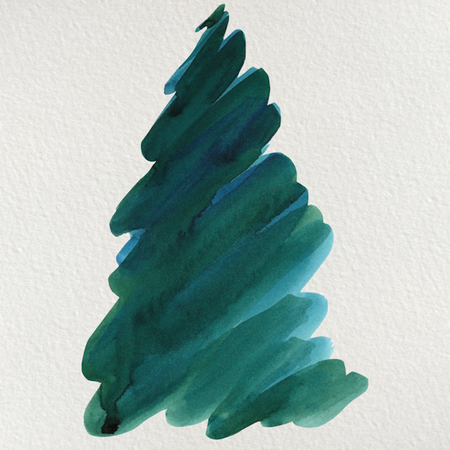
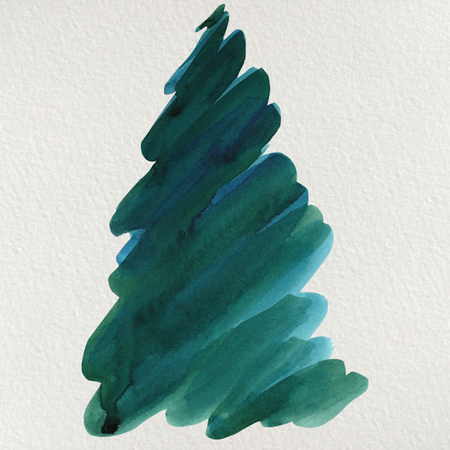


You may also like…
To purchase this lesson, click Add to Cart, then click Checkout, and follow the onscreen instructions. Once you’ve completed the order, you’ll be able to instantly access the lesson by clicking the blue button labeled with your display name in the upper-right and then selecting My Painting Lessons.
Note: DVD orders are shipped via First Class mail and should arrive within 5 to 7 business days.
With every Tim Gagnon Studio online lesson purchase, you receive:
- Immediate access – just purchase and begin painting
- Start to finish instruction – no cutouts – you’ll see every brushstroke of every painting
- Easy-to-learn techniques – develop skills to promote consistency in your style for a more professional look
- Unlimited viewing, no expiration – view the lesson as many times as you’d like, whenever you’d like
- Download the lesson directly to your hard drive for easy, offline access
- No expiration – once purchased, you’ll have access to the lesson forever
- FREE access to Critique Corner community – get/give advice, interact, and share photos of your work with other artists taking the same lesson
Tim Gagnon is the creator of online and DVD-based instructional art lessons for over 17,500 students in over 30 countries. In 2012, he was voted as one of the Top 50 Emerging Artists by Art Business News. His easy-to-learn instruction and unique, modern style has propelled him to one of the most followed artists in the United States.
Adding edges and highlights to the winter landscape
Creating a small bank of snow
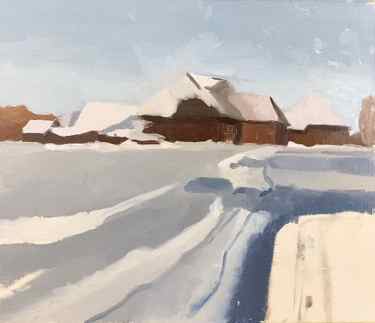
The left side of the painting above the pathway now has a bank of snow. I painted over the area with a lighter white mixture to create that lighter snow area that appears there.
I made sure though to use my palette knife and rag to scrape out any of the other more grayish white color that I would be painting over. It is better to wipe away the darker white than to try to paint over it with a lighter white. If you paint over a darker color with a lighter one it will darken and dilute the lighter color.
Painting edges in the landscape
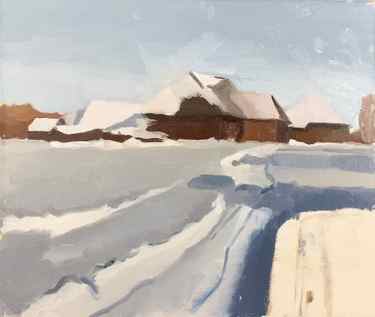
I add a few edges and highlights to both the upper edge of the pathway and also the top edge of the bank that is to the left. I mixed up a darker muted blue color to create the edges that are on the left side of the pathway. For the top part of the snowy bank I mixed a greyish color that is lighter.
The edge line/ highlight is not a thick dominant line but rather serves to simply make a distinction between one part of the painting and another.
Completing the winter landscape painting tutorial
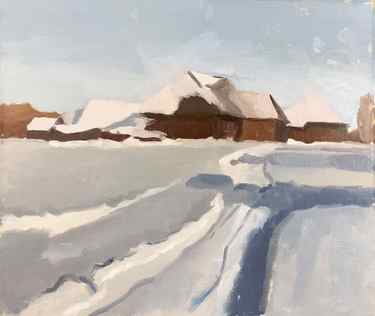
Now, I get around to painting the right side of the foreground area. First I paint in the area with a light purplish white. Then I paint a slightly darker white mixture over it on the upper part where the dark shadow meets the right foreground area.
Painting in final elements of the snowy landscape
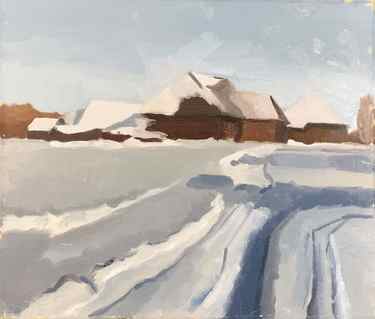
I add a few elements to finalize the winter landscape painting. First, I paint in tracks on the far right side of the painting. In addition, I also add some darker and lighter areas around those tracks to help give it dimension.
In addition, I darken the far right side of the road with a slightly darker purple color than before – this also helps to give the road more dimension.
How to mix shades of white used for this winter landscape painting tutorial
Painting a snowy winter landscape requires mixing a lot of subtle shades of white. You cannot just use the white that comes straight from the tube. A plain white is far too bright and you would never be able to create believable shadows and a sense of dimension in a snowy landscape without mixing it with other colors.
So, I will show you how to mix up different shades of white and create some variation and dimension in your winter landscape painting. However, this also applies to any painting that involves the color white!
Mixing a cool light white color
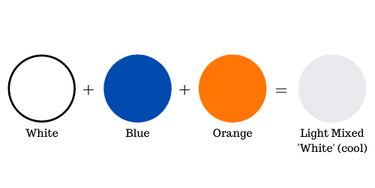
When mixing blue with white you get a light bright blue. However, when you then mix orange to the same color it mutes the blue to create a mixed white. Orange is the complementary color of blue (and vise versa) which is why mixing orange with blue will create a muted blue.
To create this mixed cool white you need to use very small amounts of blue and orange – if you use too much than the color will not be very white.
Mixing a darker cool white shade of color
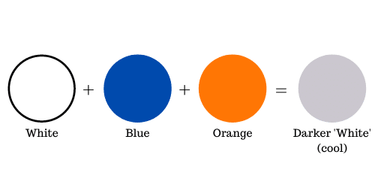
Here you can see a darker white mixture. It simply has more blue and orange mixed into it. You can always mix in more white to your white mixture if it becomes too dark. If your color is too light then you can mix in more blue and orange.
What to do if your white color turns purple?
Often when mixing a darker shade of white it can turn a little purple. When this happens simply mix in some yellow. Yellow is the complementary (opposite) color of purple and will help to mute the purple.
Mixing a warm light shade of white
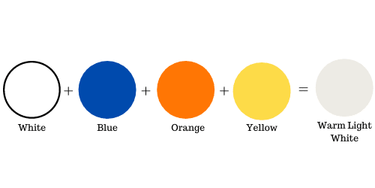
In the diagram above we can see a yellow mixed in with the orange and blue. When mixing just orange and blue with white the color often is cooler in temperature. When mixing yellow into the color as well it creates a warmer white.
Mixing a warm dark shade of white
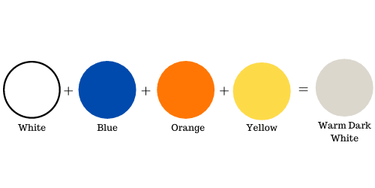
If you want a darker mixture simply mix in more blue and orange and a little more yellow. You can always mix in more white to lighten the color if it gets too dark.
Alternative colors to mix with white
You could also mix purple with white and then mute the purple/ white color with yellow to get a nice darker white. As already mentioned you can mix in more white to make the mixture lighter or make it darker by mixing in more purple/yellow.
If looking for a greenish white then mix green with white and mute the color with red. You can of course vary how much red to mix in to make it more or less muted.
Experimenting with different color mixtures
You can get a huge range of different types of whites by varying the amount of colors you mix into the white. Experiment with mixing and you will be surprised at the subtlety you can achieve in the different white mixtures. Above anything, it is important to have fun and enjoy the process!



